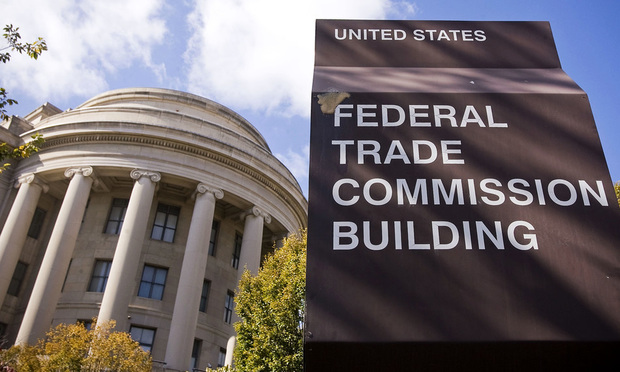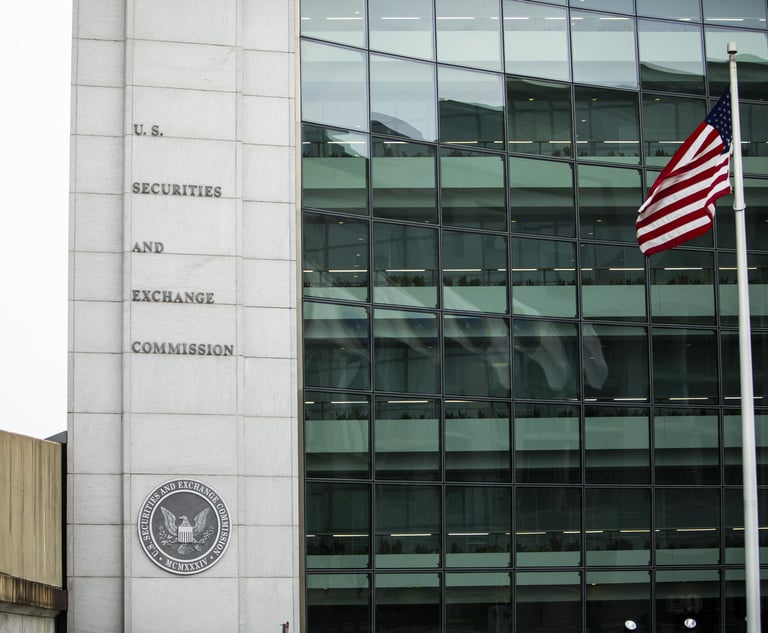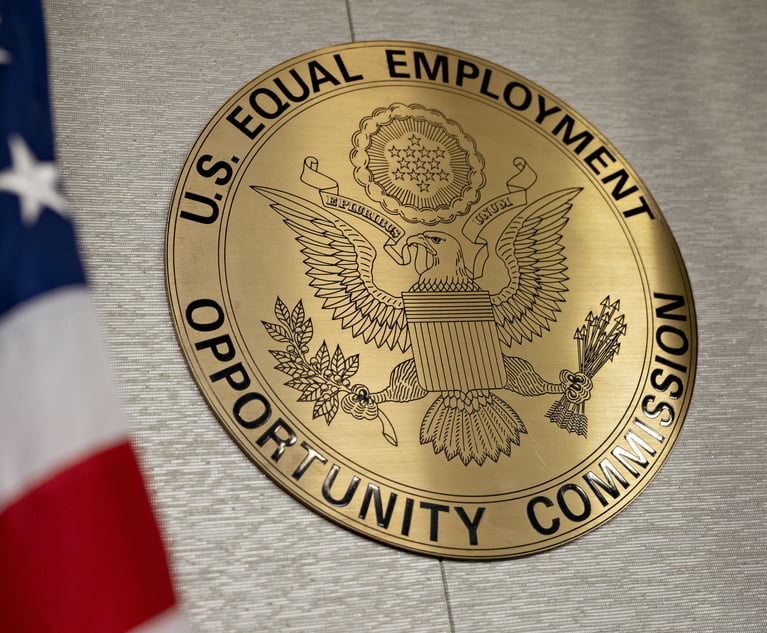The Intersection of Corporate Governance and Antitrust Law
A recent blog post from Federal Trade Commission staff serves to underscore the important interrelationship between certain types of governance arrangements and antitrust law.
August 07, 2019 at 04:11 PM
5 minute read
 U.S. Federal Trade Commission building in Washington, D.C. Photo: Diego M. Radzinschi/ALM
U.S. Federal Trade Commission building in Washington, D.C. Photo: Diego M. Radzinschi/ALM
A recent blog post from Federal Trade Commission staff serves to underscore the important interrelationship between certain types of governance arrangements and antitrust law. In this particular situation, the FTC is concerned with the potentially problematic connection between interlocking directorships with competitors and Section 8 of the Clayton Act.
At the same time, the FTC post also provides a “ping moment” about how governance structures can trigger other legal issues—not just antitrust. General counsel should coordinate with corporate strategists to assure that antitrust, and other legal issues, are addressed before a governance proposal “goes live” internally with the board, or externally in a transaction or similar corporate arrangement.
Interlocking director and officer arrangements have long been a popular means by which organizations seek to foster collaborative arrangements. Perhaps their most frequent use is as a “get to know each other” step; i.e., a limited governance connection intended as a prelude to other, more integrated arrangements.
Interlocking director arrangements are also used in certain types of corporate restructurings, “spin-off” transactions and acquisitions—especially those involving less-than-a-control position, where the minority ownership stake is supplemented by cross officers and directors.
As many general counsel know, Section 8 of the Clayton Act not only prohibits a person from acting as an officer or director of two competitors, but also prohibits any one firm from appointing two different people to sit as its agents as officers or directors of competing companies. Unlike the merger rules—with which boards and executives are somewhat familiar—Section 8 is a strict liability provision, meaning violations are per se and do not depend on actual harm to competition.
The rationale for Section 8 is based on the premise that if organizations are competitors but share a common board member or officer, then the risk exists that they might compete less aggressively against each other, including by sharing competitively sensitive information through the interlocking officer/director.
The recent FTC staff blog post encourages corporate leaders to be more aware of Section 8’s limitations in general, and particularly of the unexpected restructuring and acquisition circumstances that could lead to a potentially problematic interlock situation. The FTC post highlights Clayton Act risks arising from two particular types of transactions:
- M&A Transactions, when a company is acquiring or merging into a new business line. According to the FTC, the new business line may create an interlock if there are members of the acquiring or surviving board that also sit on the boards or serve as officers of a now-competing company. The FTC also suggests that private equity firms which acquire board seats across a diverse portfolio of companies may be particularly likely to encounter Section 8 issues via a merger or acquisition.
- Spin-offs, which can present Section 8 concerns where an officer or director retains roles with both the parent and the newly independent firm, if those two companies will compete in a line of business going forward.
The main theme of the FTC post is the need for officers, directors and in-house counsel to be aware of Section 8 when considering potential restructurings or acquisitions. In so doing, the author cleverly compares the value of Section 8 awareness with the practice of “mindfulness” (the quality or state of being conscious or aware of something). Am I living in the now, what is my position in the world, am I currently violating the per se prohibition on interlocking directorates under Section 8 of the Clayton Act?
In this regard, we’re not worried about the general counsel’s mindfulness, but rather that of executives, consultants and board members working to develop governance proposals. When it comes to Section 8 issues, are they ‘living in the same world’ as the general counsel, alert to the risk that certain kinds of governance arrangements may create certain kinds of fairly serious antitrust concerns? Or are they off in their own silo, comfortable in the false comfort that they understand corporate governance principles, and blind to the competitive implications of their proposals?
Ultimately, this is all about executive teamwork and trust. Corporate strategists should be urged not to “get ahead of the lawyers” when making governance proposals—for such proposals could “trip” many legal “wires”. Antitrust is just one (and perhaps the most serious); there are others (e.g., tax, corporate law, regulations, ethics).
Just as the general counsel knows to consult with corporate strategists to understand the rationale for arrangements he/she is asked to draft, so should the strategists consult with the general counsel to understand the legal implications of governance arrangements they expect to propose, whether internally or externally.
Where the general counsel truly serves as a business partner to management, with a secure position within the executive leadership team, such necessary coordination should flow easily. If not, time for mindfulness training in the C-Suite!
Michael W. Peregrine is a partner in the Chicago office of McDermott Will & Emery, where he practices in the corporate governance and health care restructuring areas, respectively. The author wishes to acknowledge the assistance of his partner, Ashley M. Fischer, in the preparation of this article.
This content has been archived. It is available through our partners, LexisNexis® and Bloomberg Law.
To view this content, please continue to their sites.
Not a Lexis Subscriber?
Subscribe Now
Not a Bloomberg Law Subscriber?
Subscribe Now
NOT FOR REPRINT
© 2025 ALM Global, LLC, All Rights Reserved. Request academic re-use from www.copyright.com. All other uses, submit a request to [email protected]. For more information visit Asset & Logo Licensing.
You Might Like
View All
Internal Whistleblowing Surged Globally in 2024, So Why Were US Numbers Flat?
6 minute read
Lawyers' Phones Are Ringing: What Should Employers Do If ICE Raids Their Business?
6 minute readTrending Stories
- 1Judge Sides With Retail Display Company in Patent Dispute Against Campbell Soup, Grocery Stores
- 2Is It Time for Large UK Law Firms to Begin Taking Private Equity Investment?
- 3Federal Judge Pauses Trump Funding Freeze as Democratic AGs Launch Defensive Measure
- 4Class Action Litigator Tapped to Lead Shook, Hardy & Bacon's Houston Office
- 5Arizona Supreme Court Presses Pause on KPMG's Bid to Deliver Legal Services
Who Got The Work
J. Brugh Lower of Gibbons has entered an appearance for industrial equipment supplier Devco Corporation in a pending trademark infringement lawsuit. The suit, accusing the defendant of selling knock-off Graco products, was filed Dec. 18 in New Jersey District Court by Rivkin Radler on behalf of Graco Inc. and Graco Minnesota. The case, assigned to U.S. District Judge Zahid N. Quraishi, is 3:24-cv-11294, Graco Inc. et al v. Devco Corporation.
Who Got The Work
Rebecca Maller-Stein and Kent A. Yalowitz of Arnold & Porter Kaye Scholer have entered their appearances for Hanaco Venture Capital and its executives, Lior Prosor and David Frankel, in a pending securities lawsuit. The action, filed on Dec. 24 in New York Southern District Court by Zell, Aron & Co. on behalf of Goldeneye Advisors, accuses the defendants of negligently and fraudulently managing the plaintiff's $1 million investment. The case, assigned to U.S. District Judge Vernon S. Broderick, is 1:24-cv-09918, Goldeneye Advisors, LLC v. Hanaco Venture Capital, Ltd. et al.
Who Got The Work
Attorneys from A&O Shearman has stepped in as defense counsel for Toronto-Dominion Bank and other defendants in a pending securities class action. The suit, filed Dec. 11 in New York Southern District Court by Bleichmar Fonti & Auld, accuses the defendants of concealing the bank's 'pervasive' deficiencies in regards to its compliance with the Bank Secrecy Act and the quality of its anti-money laundering controls. The case, assigned to U.S. District Judge Arun Subramanian, is 1:24-cv-09445, Gonzalez v. The Toronto-Dominion Bank et al.
Who Got The Work
Crown Castle International, a Pennsylvania company providing shared communications infrastructure, has turned to Luke D. Wolf of Gordon Rees Scully Mansukhani to fend off a pending breach-of-contract lawsuit. The court action, filed Nov. 25 in Michigan Eastern District Court by Hooper Hathaway PC on behalf of The Town Residences LLC, accuses Crown Castle of failing to transfer approximately $30,000 in utility payments from T-Mobile in breach of a roof-top lease and assignment agreement. The case, assigned to U.S. District Judge Susan K. Declercq, is 2:24-cv-13131, The Town Residences LLC v. T-Mobile US, Inc. et al.
Who Got The Work
Wilfred P. Coronato and Daniel M. Schwartz of McCarter & English have stepped in as defense counsel to Electrolux Home Products Inc. in a pending product liability lawsuit. The court action, filed Nov. 26 in New York Eastern District Court by Poulos Lopiccolo PC and Nagel Rice LLP on behalf of David Stern, alleges that the defendant's refrigerators’ drawers and shelving repeatedly break and fall apart within months after purchase. The case, assigned to U.S. District Judge Joan M. Azrack, is 2:24-cv-08204, Stern v. Electrolux Home Products, Inc.
Featured Firms
Law Offices of Gary Martin Hays & Associates, P.C.
(470) 294-1674
Law Offices of Mark E. Salomone
(857) 444-6468
Smith & Hassler
(713) 739-1250








